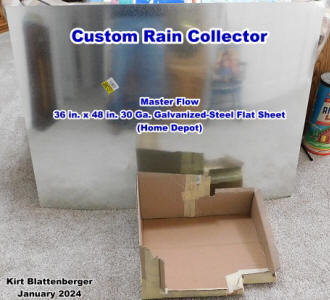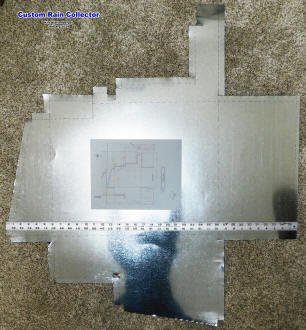|
<Previous
Next>

Custom-made rain collector. It will get painted white when the
weather gets warmer.
Nobody can say for sure where the saying originated, but the veracity of "Necessity
is the mother of invention," has been evident throughout all of mankind's existence.
You have doubtless experienced it in your own life many times, sometimes in small
ways and sometimes in big ways. We cannot all be as prolific at invention as were
Archimedes, Benjamin Franklin, and Thomas Edison, but if when the need arises and
no ready solution is available, you do it yourself or do without.
Such was the case recently when my daughter's house was experiencing massive
water infiltration during major rain downpours. The previous owners had buried a
drain pipe in the ground where the rain ran off, but by now it was almost entirely blocked
off with dirt. I could have dug up and replaced the blocked portion, which was
for at least four feet, but there was no telling how much blockage there might be farther
downstream, and the pipe runs at least 80 feet to where it empties out between two
buildings - not a good plan. Instead, I dug a new trench along the entire length
of the house and fed the two corner down spouts into it along with the new collector
in the middle. One corner downspout also emptied into a clogged drain pipe, and
the other just ran onto the top of the ground. Like I said - bad planning.

South-looking view of house showing original gutter and downspout
configuration.

Rain collector cardboard prototype and galvanized sheet metal.

30-gauge galvanized steel template cut and ready for folding.

Completed rain collector inside, top view.

Completed rain collector outside, bottom view.
As can be seen in the photos, where the roof sections converge to form a valley,
there is no effective way to install traditional gutters. During a heavy rain, the
water runs off with such force that it shoots out a foot past the edge. All that
water was seeping into the ground and into the house. The floor below the three
most distant windows is about three feet below grade level, with nowhere to go.
Beyond the far edge of the house is a three foot retaining wall that traps the water,
too. As I said, it was very poorly planned.
Because the roof sections do not converge at the same place, a very complex shape
was required for the rain collector. Also, it needed to be high enough to capture
the significant flow past the edges. Rather than suffer through trial and error
with sheet metal, I first measured and cut a prototype out of corrugated cardboard.
That way I could assure all the angles and surface contact areas were correct and
fit snugly. Satisfied with the result, I generated an "unfolded, flattened out"
dimensioned scale drawing (using
Visio) for
transferring to the
30-gauge galvanized sheet metal. Outline cut (solid) and bend (dashed) lines
were used, along with arrows to remind me of which way to make each bend. Only one
small corner section needed to be fabricated separately. I was surprised to discover
how large of a piece of metal was needed. The largest piece sold by Home Depot was
36" x 48", and that was about 3" too short in one dimension, so I had to attach
an extension strip on one edge.
After transferring the pattern to the sheet metal, tin snips were used to cut
the outline and fold tabs. The first thing to do was attach the extension piece.
Folded, interlocking seams were used where practical. Gutter seam sealant was used
at all joints. 1/8" steel pop rivets were used everywhere in order to minimize the
opportunity for dissimilar metal corrosion.
Next, a broad-faced cold chisel was carefully hammered along the bend lines in
order to obtain straight lines with a small radius. Only a few degrees of bend was
needed to establish the line, then hand bending completed the 90° angles. All
corner seams were overlapped for strength and optimal sealing. Once bending was
complete, holes were drilled for all the rivets, using a few 4-40 nuts and bolts
to hold things temporarily. The rain collector was trial-fitted in place, and only
a couple minor adjustments were needed for the flanges that would be used to mount
it to the fascia and eaves. I also verified the location for the downspout adapter.
Sufficient gutter seam sealant was applied to all the joint areas to assure a
leak-proof joint, and then the pop rivets were installed. A cutout was made for
the downspout adapter and it was similarly installed with sealant and rivets. Care
was taken to wipe off excess sealant to have a nice clean, finished product.
After giving the sealant a day to set, the rain collector was installed and connected
with downspout into the newly installed drain pipe. As the photos show, it fits
like a glove. Once the weather warms up a bit, I'll take the rain collector down
and paint it white.
The drain pipe (solid wall, not perforated wall) runs out to the entrance road
with a sufficient downslope to assure excellent drainage. About two weeks later we
had another downpour, so I got in the car and drove over to the pipe exit and watched
a torrent of water gush from the opening. No water had entered the house since that
time.
Check. Another "Dad" job done!

Using chisel to define bend lines in sheet metal.
Posted February 8, 2024
|

























 "
"






